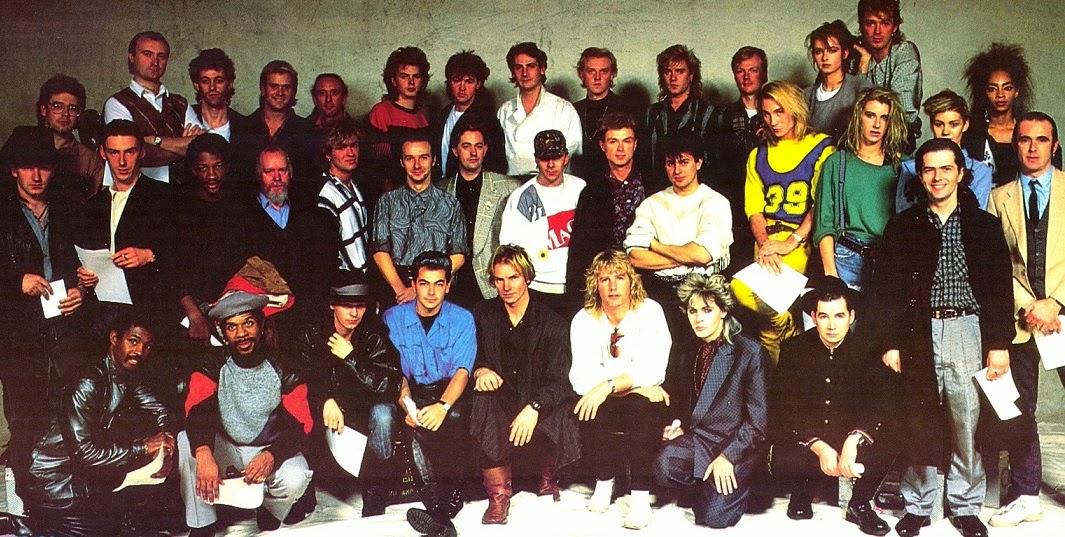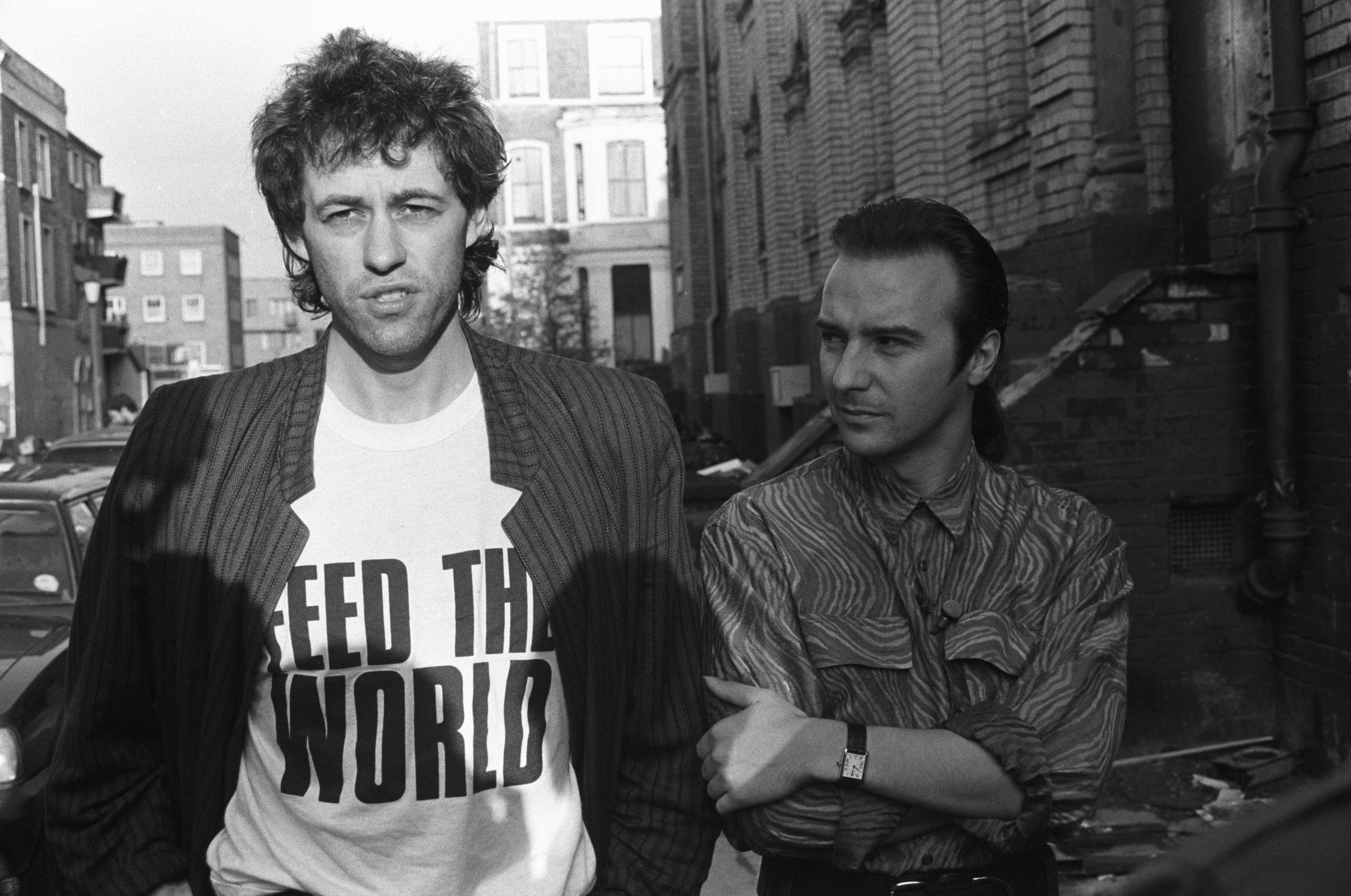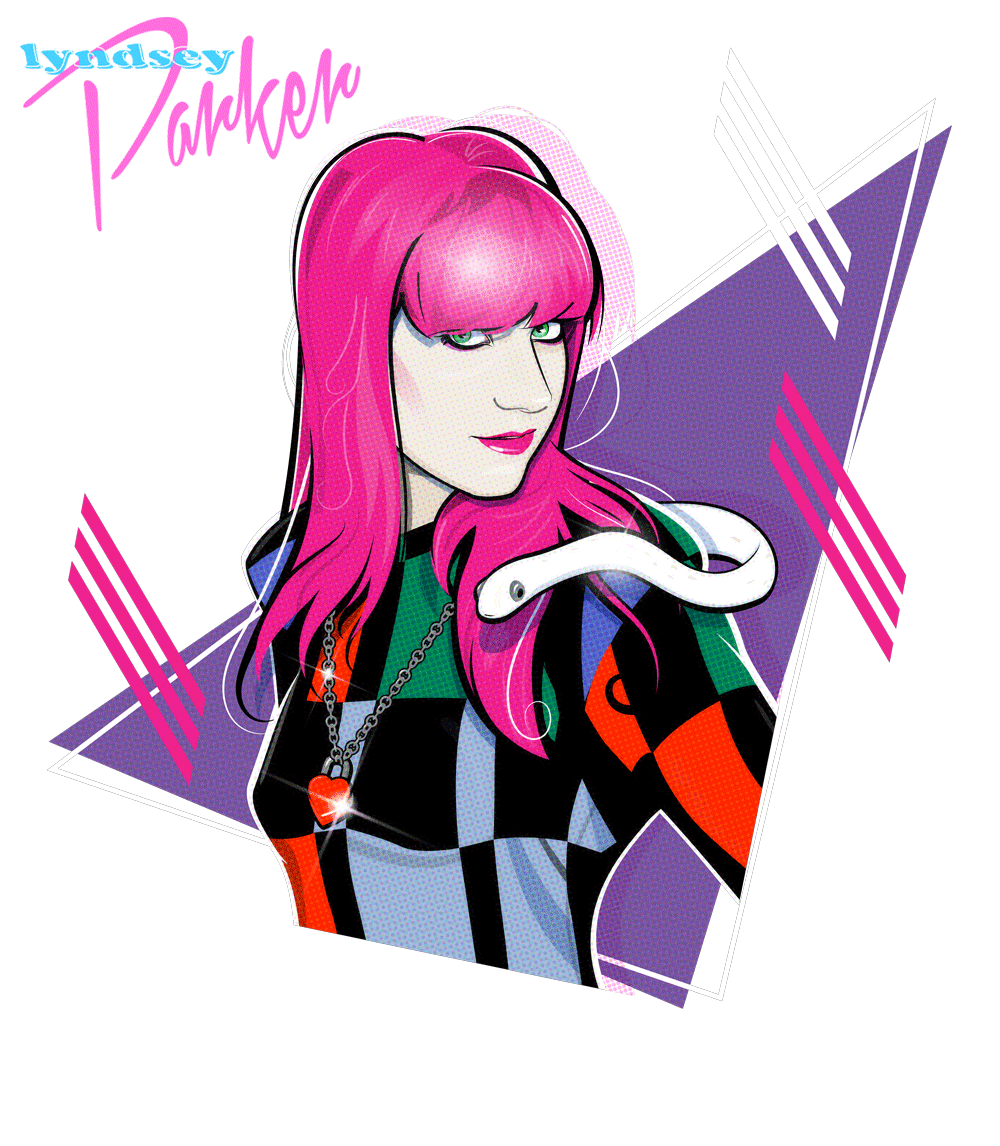
The cast of Band Aid in 1984. (Photo: Polydor)
Thirty-four years ago, on Nov. 25, 1984, new wave’s elite came together to record “Do They Know It’s Christmas?,” a now-legendary holiday benefit single for Ethiopian famine relief. Most people remember that the Boomtown Rats’ Bob Geldof, who was inspired to do the project after watching an October 1984 BBC report about the crisis in Ethiopia, was at the helm, and that the famous song was belted by superstars like Simon Le Bon, Boy George, Sting and Bono. But not everyone realizes that Band Aid would not have existed without Midge Ure of Ultravox, who co-wrote and produced the track and even played almost all of the instruments on the final recording.
But strangely, Ure doesn’t think “Do They Know It’s Christmas?” is that great a song.
“I’ve been misquoted many times as saying it’s the worst song I’ve ever written, and it’s certainly not — I’ve written much worse! — but as a song, it’s OK,” Ure tells Yahoo Entertainment with a shrug. “As a record, it’s exceptional; as a moment in time, it’s phenomenal for what it was. But as a song, meh. It’s no ‘White Christmas.’ … I still think of it as an OK song that became something much better than it actually was.”
Whether Ure’s surprisingly unenthusiastic assessment of “Do They Know It’s Christmas?” is correct, and even if the song has since been criticized for being patronizing and self-righteous, there’s no denying that it made a cultural impact at the time. Rush-released just days after it was recorded in a whirlwind all-nighter session at Trevor Horn’s SARM Studios in London (Horn donated the studio time, free of charge), the single shot straight to No. 1 in Britain and stayed there for five weeks — becoming the biggest-selling single in U.K. chart history at the time. It went on to sell 3.8. million copies in the United Kingdom alone, and 12 million worldwide.
The song has since been re-recorded by three other “Band Aids,” in 1989, 2004 and 2014 — but Ure confirmed last year that there will never be another be another remake, out of respect for two of the original recording’s participants, George Michael and Status Quo’s Rick Parfitt, who recently passed away. However, Ure confesses, “I’m not denying that every time I hear the opening bars of that [1984] song as I’m walking around the supermarket or wherever, that opening clang still sends shivers up my spine. So, as a record, it really did achieve its goals.” The original “Do They Know It’s Christmas?” eventually raised over $24 million, and inspired other well-meaning pop-music charity efforts of the ’80s, like USA for Africa’s “We Are the World” and Geldof’s global Live Aid concerts.
Read on for Yahoo Entertainment’s interview with the man who was behind the mixing board for the legendary Band Aid session, for the inside scoop on Boy George’s near no-show, Duran Duran’s “shenanigans,” Bono’s big breakout moment, that unauthorized Tears for Fears sample, and more.
Yahoo Entertainment: Surely you must have realized you were doing something historical with Band Aid, right?
Midge Ure: I think there’s a power in naiveté, and there was an awful lot of naiveté in putting Band Aid together. Our goal at the time was simply to try and get a No. 1 record in the U.K., which would have raised in the region of 100,000 pounds. We couldn’t see beyond that. But I recall as I was driving home from the studio at 8 o’clock in the morning the next day [after the one-day recording session], Bob took a cassette to the BBC. I heard them on the radio playing the cassette, and I thought, “This is something special. The BBC don’t play cassettes!” And the moment the song finished, they played it again. And then they played it every hour on the hour — from a cassette — while the master tapes went straight to the factory to get pressed up. So, at that moment, I knew something odd had happened, something that had never happened before.
So, let’s talk about that recording session from the night before. How did you recruit all this A-list talent?
Well, when Bob gets a bit between his teeth, he doesn’t take no for an answer. So he wouldn’t speak to a manager or a record label or an agent — he would find the phone number for the artist and he’d speak to the artist himself, which was brilliant. He just cut through the red tape. While I was in the studio twiddling knobs and layering up keyboards and writing drum parts, he was on my telephone, running up huge telephone bills, because he was calling these guys all around the world! Duran Duran were on tour, Spandau Ballet were on tour, and Sting’s always on tour, so it was really difficult to nail them down. But he spoke to them directly — which in itself is exceptionally dangerous, simply because if you don’t speak to a manager, if you speak directly to an artist, there’s a very good chance that the artist is not going to write anything down. He’ll just go, “Yeah, yeah, I’ll be there!” — and then have no idea what it was he just agreed to do. Artists are a little bit flaky. So there was a moment when Bob and I were standing outside SARM Studios in London with camera lenses stuck in our noses, just a sea of media, and we hadn’t a clue who was going to show up. Nobody had confirmed. We’d given the date and given them the time, and kind of just hoped that they’d remember. But they all turned up! I don’t think there was one person who said they’d be there who wasn’t.
A Christmas miracle! But I heard Boy George almost didn’t make it.
George was the closest person to missing it. He was still in New York. He forgot all about it. He was sleeping in his hotel room in New York and Bob called him and said, “Where are you, you’re meant to be here!” And George said, “Oh, is it today? Who else is there?” And Bob said, “Every f***er in music is here but you. Get up and get on a plane and get here!” And George did. He turned up at 7 or 8 o’clock at night, and walked straight in and sang his vocal brilliantly.
So, who sang first?
You’ve got to remember that all these people turned up not having heard one note of the song. It wasn’t like these days, where you’d be able to email someone the track and they’d be able to listen to it in advance. So there was no vying for first position. Nobody wanted to go first, which was totally understandable; they were about to sing a song they didn’t know in front of all their peers, and they’ve got a film camera in front of them. It’s the worst possible scenario for any musician. Tony Hadley from Spandau Ballet was the first person to get up there and do his thing, and he did it brilliantly and that broke the ice. After that, it was easy.
Were there any ego battles over who got to sing what?
As I said, not a lot of this was planned. We hadn’t even thought who was going to sing each line! There weren’t even enough lines in the song for all the vocalists to have a go. I mean, I don’t have a line, and neither does Bob. It was more important getting really distinctive global voices on there. Paul Young was huge at the time, George was huge, Sting was huge. Interestingly enough, the guy who kind of stole the moment was Bono, who was at that time still kind of a college-rock artist; U2 hadn’t really attained the massive heights they were going to eventually attain. Bono came in and just went for it. When I assigned that original line on the guide vocal, it was an octave lower. It was almost a throwaway line. And he just jumped the octave and belted this thing out. It was incredible. It was a serious turning point in the record. When he did that, it kicked the song off. It went into another gear at that point.
So, there were no ego clashes? Everyone got along?
I think initially it was a little awkward, because there’d be people there that had slighted other artists in various interviews, ripping someone else’s record to shreds a couple weeks before in NME or something. But you get over that; it’s not a reason to sulk in the corner or not talk to anyone. It was actually a very jovial atmosphere in the studio. I think the really great thing was there was no record company behind us; there was no label, no management, no one was laying on drinks, no one was laying on food. If you wanted a sandwich, you had to go to the shop ’round the corner and go buy one. Boy George came in after flying in on the Concorde and kind of snapped his fingers and said, “Someone get me a brandy!” And I pressed the button on the intercom and said, “You’ll have to get it yourself, there’s no flunkies here!”
Was there a lot of partying going on in the studio?
I think there was some shenanigans going on with, I think, Status Quo and Duran Duran, and possibly some forms of illicit substances flying around. But I was sitting behind a mixing desk for 24 hours, so I didn’t really get a chance to indulge in anything other than sitting there, making a record. By 8 o’clock Sunday evening we had to throw everyone out because we had to start mixing the record; it had to be in the pressing plant the next morning, otherwise we’d not get the thing finished and in the stores for Christmas. So we had to throw everyone out, and no one wanted to leave! All these rich, famous rock stars, all in one of the most vibrant cities in the world, and they didn’t want to go anywhere! They were having such a good time just hanging out, just being part of this thing. It was quite incredible.
How did you become involved with Band Aid in the first place?
I think like most things, there was no real plan. I happened to be in the right place, or the wrong place, at the right time. I was doing a TV show in the north of England which [Bob Geldof’s] girlfriend at the time, Paula Yates, co-hosted, when Bob called Paula. He said, “Let me speak to Midge,” and he told me about the footage he’d just seen on BBC News about the famine in Ethiopia. He said how disgusted he was and he wanted to do something, but didn’t know what. … We came up with the obvious conclusion that the only thing we were kind of semicapable of doing was writing a song. So Bob had half an idea kicking around; I went home and worked on another idea, and then proceeded to spend the next three or four days trying to put these totally incompatible ideas together.

Bob Geldof and Midge Ure outside SARM Studios during the recording of “Do They Know It’s Christmas?” (Photo: Larry Ellis/Express Newspapers/Getty Images)
You really wrote the song that quickly?
Yeah, three or four days. I sent Bob a cassette of me playing on a little Casio keyboard. He hated it! Then he came to my house with a guitar; he plays a right-handed guitar, but left-handed, so he played this thing upside-down, and it was missing a lot of strings as well. He sang what he had, and every time he sang it, it was different. So he was obviously just kind of shooting from the hip. I recorded his part on a cassette and started gluing these ideas together in my studio, trying to do some kind of arrangement on this very, very shaky idea.
I think the part people most remember from that song is the “Feed the World” refrain…
Well, that was the last thing to come, believe it or not! That was the last thing we did. If you listen to the song, it’s a song with no real pop sensibilities. There’s no real structure to it. Most songs have an intro and a verse and then a chorus, but this is just a thing that started and kind of grew. It didn’t really have anything you could sing along with. It was very obvious to Bob and I that it needed something at the end, so between the two of us we came up with the “Feed the World” hook. It’s a very strange thing, putting a hook of a song at the very end. In many ways it was such an alien, unusual arrangement. I do still think to this day that having all these artists added strength to the record. It otherwise would have been a dreadful flop as a commercial record. It wasn’t overtly commercial.
Is it true that you played almost all of the instruments on the song?
Yes, all of them, except for Phil Collins’s drums.
But we see people like John Taylor of Duran Duran playing bass in the music video…
Kind of, yeah. John played the bass, but it just didn’t sound right playing an electric bass amongst all this electronic stuff. So John put a bassline down, but it’s mixed way, way, way quiet. A few other people put guitars down as well, which again we just decided not to use, because it just kind of jarred against the version that we had. I spent four days in my studio doing all the instruments, so everything we had on the record except the vocals and Phil’s drums are mine.
I know Tears for Fears didn’t participate in the recording session itself, but isn’t there a Tears for Fears sample on there?
Yeah, there is! I didn’t ask them, I just did it! Samples were quite new at the time, and I was a big Tears for Fears fan. I thought their productions were wonderful — great songwriters, great band. I lifted the drum sound at the beginning of “The Hurting” because there’s one single tom sound, and I sampled that tom and started layering it up and playing drum patterns with it, and mixed it in with all my multitrack vocals at the front of the record, so it was drones and noises and things — a mixture of Tears for Fears’ drums and my voice.
Were they upset about this?
Weirdly enough, when they found out about it, I think they were actually quite pleased to learn they had contributed to the record, even though they didn’t know much about it at the time. I think they felt quite pleased that something of theirs was on it.
Would you say “Do They Know It’s Christmas?” was your career highlight?
Well, I think it was very much a product of the arrangement at the time, very much a product of something that Bob and I put together as a one-off. We’ve never written together since, and I can’t imagine we’ll ever write together again. We’re very, very different musical characters as well as emotional characters. … People always ask me what the highlights of my career are, and they always expect me to say Band Aid. I say, well, it’s not necessarily my career highlight, but it was a highlight in my life. None of this was done for favor, none of this was done to get a pat on the back, none of this was done to get a knighthood. It was done in a very basic way, on gut instinct, as an absolute reaction to something that shouldn’t have been happening in our world at the time. I happened to be there and luckily, because Bob and I are chalk and cheese, we managed to pull this thing off. I’ll just say it was quite a magnificent thing. And who would have thought, 30 years later, it would still be getting played — and that it might still be getting played 30 more years down the line?
This article originally ran on Yahoo Music.







